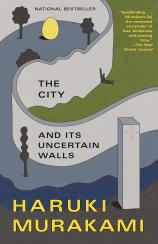The City and Its Uncertain Walls
Review
The City and Its Uncertain Walls
Haruki Murakami and his translator, Philip Gabriel, have crafted a BRIDGE TO TERABITHIA for more mature audiences. While Terabithia is strictly an imaginative play world for its protagonists, Murakami shrouds his dream town in titular uncertainty. On one end, like Terabithia, it’s how two hesitant young lovers express themselves. But unlike Terabithia, Murakami’s readers find themselves wondering if a dream town, which mandates that citizens get magically stripped of their own shadows, is as real as awkward teenage romance.
A novel that dances between the past --- through memories within a solid, familiar reality --- and the present with its fantastical worldbuilding, THE CITY AND ITS UNCERTAIN WALLS is a vibrant invitation into the fantasy genre.
Novels told through short chapters of 10-15 pages or less have been growing in popularity ever since smartphones and social media declared war on attention spans. Screens and phones are like immediate-release medicines, enticing because of their instant effects, whereas novels are like extended-release medicines, offering long-acting entertainment that takes time to fully reveal itself. While Murakami did not invent the short chapter structure, he certainly masters it here, making each chapter feel thoughtful and character-driven rather than connecting dots of plot points.
"While Murakami did not invent the short chapter structure, he certainly masters it here, making each chapter feel thoughtful and character-driven rather than connecting dots of plot points."
The first two chapters wisely introduce the adolescent characters and their slowly blossoming romance. They are the heart of the story and why audiences should care to keep turning pages. Readers quickly learn of a dream town that they talk and fantasize about, wherein the young man’s girlfriend is already a librarian, and someday he would be a good fit for the “Dream Reader” job. By the third chapter, though, readers are brought into the town itself --- no more eavesdropping on the imaginations of teens --- and witness the town’s Gatekeeper blowing a horn to signal to the gentle, unicorn-like “beast” creatures to congregate outside the town.
Within the first two dozen pages, Murakami establishes concrete narrative past and present. In the past, a boy fell in love with a girl at a high school essay contest ceremony, until she disappeared. In the present, the now-middle-aged man has somehow entered the dream town looking for his first love.
Perhaps a result of Japanese-to-English translation, or maybe a peculiar but effective stylistic choice, THE CITY AND ITS UNCERTAIN WALLS is told through second-person narration. The man narrates personally, saying “I” and “my,” but is chronically telling and describing the story to “you” --- his missing girlfriend. While rare and admittedly a little difficult to adjust to, the book seems to wield second-person well enough, making the reading experience feel, fittingly, like a love letter that readers are snooping through.
Murakami even appears to have a little fun with the nature of writing to “you.” At some points, the narration is crafted to make the “you” feel directed at readers while maintaining the love letter structure. When the man and woman were discussing dreams, for instance, he opted to conveniently leave out the sexual ones he had about her. He internally pondered the nature of secrets, asserting that they help humans stay sane and asking, “Wouldn’t you agree?”
The man learns that the details his girlfriend had told him about the dream town are consistent when he finally enters it. He has gained entry since he would make a good Dream Reader, so he must be stripped of his shadow, and his eyes need to undergo a mystical change to enable dream reading. As she had warned, he can never leave the town once he has entered. When he goes to the library to start reading dreams, he finds his lost lover. But she has no memory of him or their lives outside the town. She also maintains the young age she was when she disappeared, whereas he is the middle-aged man he became in the years following their separation.
While the man is happy to be working closely with who he sought to find, he struggles to read dreams effectively. As the seasons pass and he spends more time in the town, he cannot help but wonder about the boundaries between the world in which he met his girlfriend and the world he is in now, and if the town is truly as tranquil as a town with unicorns and dream reading seems.
Aside from fantasy and young love, THE CITY AND ITS UNCERTAIN WALLS has some popular stylistic trends permeating, like short chapters and competing past and present narratives, as well as some rarer and more unique traits, like second-person narration. Although this review began with comparing the book to a slightly similar novel, it is hard to pinpoint moments that feel repetitive.
Reviewed by Sam Johnson on November 22, 2024
The City and Its Uncertain Walls
- Publication Date: September 9, 2025
- Genres: Fiction, Magical Realism
- Paperback: 464 pages
- Publisher: Vintage
- ISBN-10: 0593687841
- ISBN-13: 9780593687840




